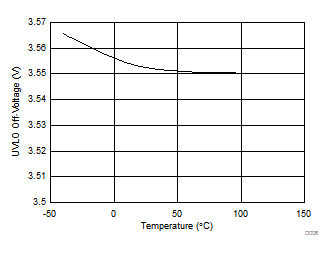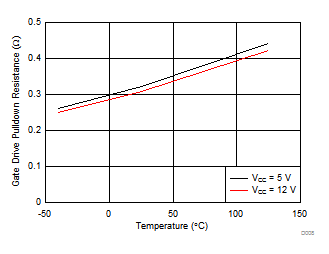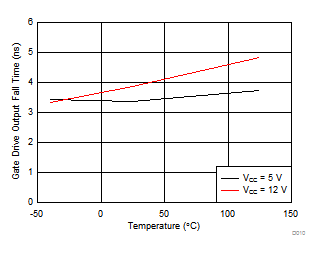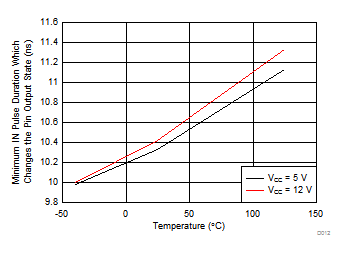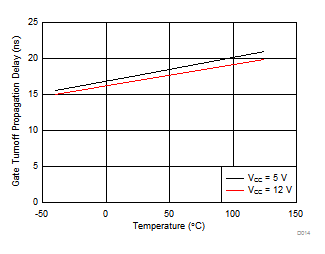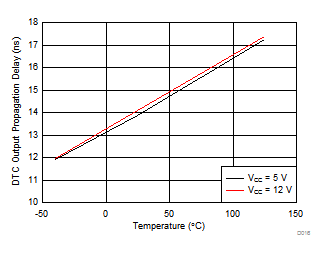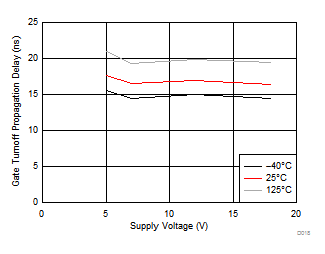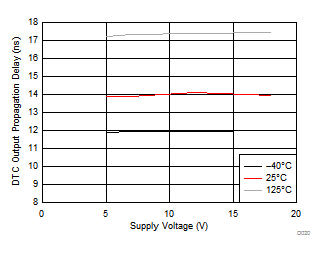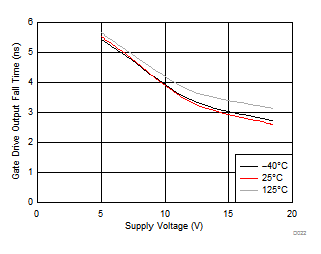SLVSCS1B March 2015 – May 2015 UCD7138
PRODUCTION DATA.
- 1 Features
- 2 Applications
- 3 Description
- 4 Simplified Schematic
- 5 Revision History
- 6 Pin Configuration and Functions
- 7 Specifications
- 8 Detailed Description
- 9 Application and Implementation
- 10Power Supply Recommendations
- 11Layout
- 12Device and Documentation Support
- 13Mechanical, Packaging, and Orderable Information
Package Options
Mechanical Data (Package|Pins)
- DRS|6
Thermal pad, mechanical data (Package|Pins)
Orderable Information
7 Specifications
7.1 Absolute Maximum Ratings
over operating free-air temperature range (unless otherwise noted) (1)| MIN | MAX | UNIT | ||
|---|---|---|---|---|
| Input voltage | VCC | –0.3 | 20 | V |
| IN, CRTL | –0.3 | 3.8 | ||
| VD | –1 | 45 | ||
| Maximum VCC continuous input current | DC current | 50 | mA | |
| Output current, peak (pulse) | 6 | A | ||
| Switching frequency, ƒS | 2000 | kHz | ||
| Operating junction temperature, TJ | –40 | 125 | °C | |
| Lead temperature, soldering, 10 s, T(SOL) | 300 | °C | ||
| Storage temperature, Tstg | –65 | 150 | °C | |
(1) Stresses beyond those listed under Absolute Maximum Ratings may cause permanent damage to the device. These are stress ratings only, which do not imply functional operation of the device at these or any other conditions beyond those indicated under Recommended Operating Conditions. Exposure to absolute-maximum-rated conditions for extended periods may affect device reliability.
7.2 ESD Ratings
| VALUE | UNIT | |||
|---|---|---|---|---|
| V(ESD) | Electrostatic discharge | Human body model (HBM), per ANSI/ESDA/JEDEC JS–001, all pins(1) | ±2000 | V |
| Charged device model (CDM), per JEDEC specification JESD22-C101, all pins(2) | ±500 | |||
(1) JEDEC document JEP155 states that 500-V HBM allows safe manufacturing with a standard ESD control process.
(2) JEDEC document JEP157 states that 250-V CDM allows safe manufacturing with a standard ESD control process.
7.3 Recommended Operating Conditions
over operating free-air temperature range (unless otherwise noted)| MIN | NOM | MAX | UNIT | ||
|---|---|---|---|---|---|
| VCC | VCC input voltage from a low impedance source | 4.5 | 18 | V | |
| VIN | Input voltage | 0 | 3.6 | V | |
| C(BP) | VCC bypass capacitor | 1 | µF | ||
| TJ | Operating junction temperature | –40 | 125 | °C | |
7.4 Thermal Information
| THERMAL METRIC(1) | UCD7138 | UNIT | |
|---|---|---|---|
| DRS (WSON) | |||
| 6 PINS | |||
| RθJA | Junction-to-ambient thermal resistance | 73.4 | °C/W |
| RθJC(top) | Junction-to-case (top) thermal resistance | 84.2 | |
| RθJB | Junction-to-board thermal resistance | 46.3 | |
| ψJT | Junction-to-top characterization parameter | 2.6 | |
| ψJB | Junction-to-board characterization parameter | 46.4 | |
| RθJC(bot) | Junction-to-case (bottom) thermal resistance | 12.4 | |
(1) For more information about traditional and new thermal metrics, see the Semiconductor and IC Package Thermal Metrics application report, SPRA953.
7.5 Electrical Characteristics
At VCC = 12 VDC, –40°C < TJ = TA < 125°C, 1µF capacitor from VCC to GND, all voltages are with respect to ground and currents are positive into and negative out of the specified terminal, unless otherwise noted. Typical values are at TJ = 25°C.| PARAMETER | TEST CONDITIONS | MIN | TYP | MAX | UNIT | |
|---|---|---|---|---|---|---|
| VCC BIAS SUPPLY | ||||||
| ICC(UV) | VCC current, undervoltage | VCC = 3.4 V | 122 | 186 | µA | |
| ICC(ON) | VCC current, no switching | VCC = 12 V | 0.85 | 1.1 | mA | |
| ICC(OPERATE) | VCC current, normal operation (1) | VCC = 12 V, C(LOAD) = 10 nF, ƒ = 100 kHz |
13 | 17 | mA | |
| GATE INPUT (IN) | ||||||
| VIH | Input signal high threshold | 1.93 | 2.03 | 2.10 | V | |
| VIL | Input signal low threshold | 0.98 | 1.03 | 1.08 | V | |
| VI(hys) | Input hysteresis | 0.90 | 1.00 | V | ||
| DTC OUTPUT | ||||||
| VOL(DTC) | Low level output voltage | 0.25 | V | |||
| VOH(DTC) | High level output voltage | 2.5 | V | |||
| IOH(DTC) | Output sinking current | 4 | mA | |||
| IOL(DTC) | Output sourcing current | –4 | mA | |||
| VDTC | Maximum DTC pin output voltage | 3.5 | 3.6 | V | ||
| UNDERVOLTAGE LOCKOUT SECTION (UVLO) | ||||||
| VCC(ON) | VCC turnon threshold | 3.30 | 3.80 | 4.30 | V | |
| VCC(OFF) | VCC turnoff threshold | 3.10 | 3.56 | 4.02 | V | |
| VCC(hys) | UVLO hysteresis | VCC(hys) = VCC(ON) – VCC(OFF) | 0.24 | V | ||
| COMPARATOR | ||||||
| VTH | Body diode conduction sensing threshold | –179 | –147 | –113 | mV | |
| CI(VD–ground) | Differential input capacitance between VD and ground (1) | VD = –150 mV | 20 | pF | ||
| GATE DRIVER | ||||||
| VCC-VOH | Output high voltage | IOUT = –10 mA | 0.038 | 0.064 | V | |
| VOL | Output low voltage | IOUT = 10 mA | 0.0025 | 0.009 | V | |
| R(UP) | Pullup resistance | TA = 25°C, IOUT = –25 mA to –50 mA |
5 | 6.1 | Ω | |
| TA = –40°C to 125°C, IOUT = –50 mA |
5 | 6.3 | Ω | |||
| R(DOWN) | Pulldown resistance | TA = 25°C, IOUT = 25 mA to 50 mA |
0.31 | 0.44 | Ω | |
| TA = –40°C to 125°C, IOUT = 50 mA |
0.33 | 0.45 | Ω | |||
| IO(source) | Output peak current (source) (1) | C(LOAD) = 0.22 µF, ƒS = 1 kHz, 5-V output |
–4 | A | ||
| IO(sink) | Output peak current (sink) (1) | C(LOAD) = 0.22 µF, ƒS = 1 kHz, 5-V output |
6 | A | ||
(1) Ensured by Design, not tested in Production.
7.6 Switching Characteristics
At VCC = 12 VDC, –40°C < TJ = TA < 125°C, 1µF capacitor from VCC to GND, all voltages are with respect to ground and currents are positive into and negative out of the specified terminal, unless otherwise noted. Typical values are at TJ = 25°C.| PARAMETER | TEST CONDITIONS | MIN | TYP | MAX | UNIT | |
|---|---|---|---|---|---|---|
| tr | Rise time | C(LOAD) =1 nF, VCC = 5 V, See Figure 1 and Figure 24 |
5 | 8 | ns | |
| C(LOAD) =1 nF, VCC = 12 V, See Figure 1 and Figure 24 |
4 | 8 | ns | |||
| tf | Fall time | C(LOAD)=1 nF, VCC = 5 V, See Figure 1 and Figure 24 |
3.36 | 5 | ns | |
| C(LOAD)=1 nF, VCC = 12 V, See Figure 1 and Figure 24 |
3.5 | 5 | ns | |||
| tw(VD) | Minimum VD pulse duration (width) that changes the DTC output state | VCC = 5 V | 10 | 23 | ns | |
| VCC = 12 V | 10 | 23 | ns | |||
| tw(IN) | Minimum IN duration (width) that changes OUT state | VCC = 5 V | 11 | 13 | ns | |
| VCC = 12 V | 11 | 13 | ns | |||
| td(1) | Gate driver turn on propagation delay | C(LOAD) = 1 nF, VIN = 0 V to 3.3 V, VCC = 5 V, VVD = –0.5 V, See Figure 1 and Figure 24 |
14 | 26.6 | ns | |
| C(LOAD) = 1 nF, VIN = 0 V to 3.3 V, VCC = 12 V, VVD = –0.5 V, See Figure 1 and Figure 24 |
14 | 25 | ns | |||
| td(2) | Gate driver turn off propagation delay | C(LOAD) = 1 nF, VIN = 3.3 V to 0 V, VCC = 5 V, See Figure 1 and Figure 24 |
14 | 22.9 | ns | |
| C(LOAD) = 1 nF, VIN = 3.3 V to 0 V, VCC = 12 V, See Figure 1 and Figure 24 |
14 | 22 | ns | |||
| td(COMP) | Body-diode conduction detection-comparator controlled-turnon propagation delay(1) | C(LOAD) = 1 nF, VIN = 3.3 V, VCC = 5 V, VVD = 2 V to –0.5 V, See Figure 24 | 28 | 36 | ns | |
| C(LOAD) = 1 nF, VIN = 3.3 V, VCC = 12 V, VVD = 2 V to –0.5 V, See Figure 24 | 26 | 33 | ns | |||
| td(DTC) | DTC output propagation delay | VCC = 5 V | 21 | 27 | ns | |
| VCC = 12 V | 18 | 25 | ns | |||
(1) For details about the operation, see the Gate Turnon and Turnoff section.
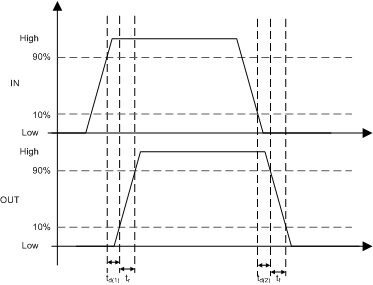 Figure 1. Input Driver Operation
Figure 1. Input Driver Operation
7.7 Typical Characteristics
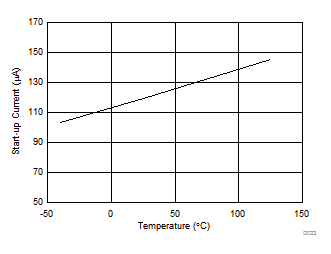
| VCC = 3.4 V |
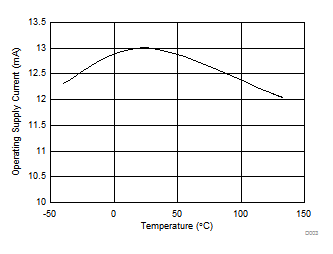
| VCC = 12 V | C(LOAD) = 10 nF | ƒ = 100 kHz |
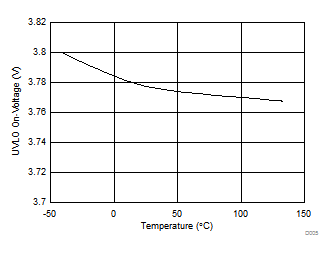
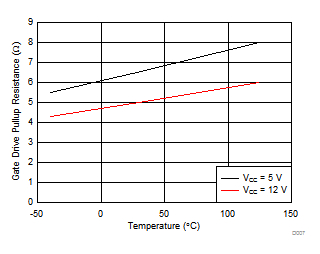
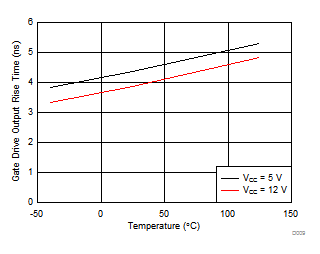
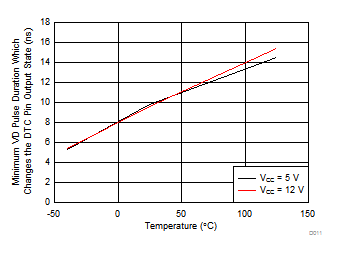
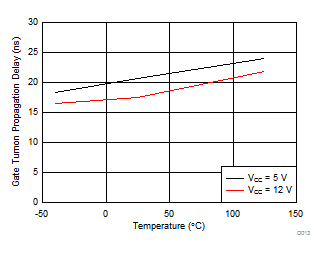
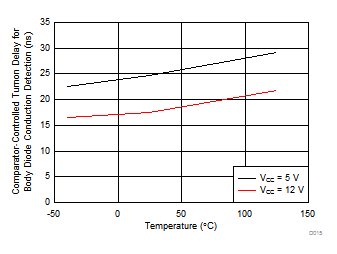
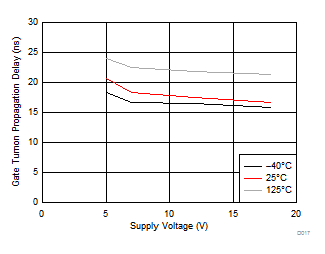
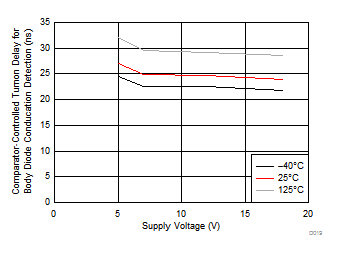
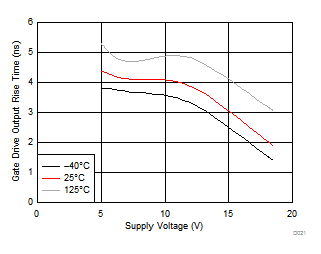
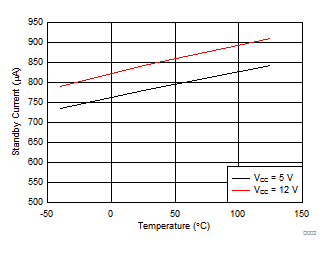
| No switching |
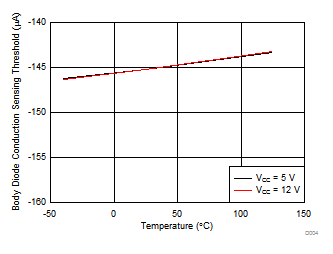
| VCC = 12 V |
